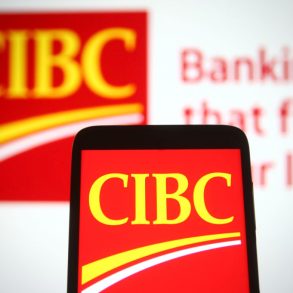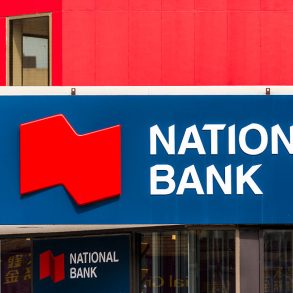Over half of CIBC’s variable-rate mortgage holders are seeing all of their mortgage payments go towards servicing interest costs.
In its first-quarter earnings release, CIBC said that $52 billion worth of its mortgage portfolio “relates to mortgages in which all of the fixed contractual payments are currently being applied to interest” as of January 31. For those whose payments can’t meet their contractual payment obligations, that amount is being re-applied to the principal, the bank said.
CIBC has a total mortgage portfolio of $263 billion, of which more than a third (37%) have variable rates. As a result of rising interest rates from the Bank of Canada, CIBC, like several of the other big banks, has seen mortgage amortization periods for its fixed-payment variable-rate mortgages soar.
Over a quarter (27%) of CIBC’s residential mortgage portfolio now has an effective amortization of 35 years or longer, the bank reported as part of its Q1 earnings release.
Remaining amortizations for CIBC residential mortgages
| Q1 2023 | Q1 2022 | |
| 20-25 years | 31% | 45% |
| 25-30 years | 17% | 27% |
| 30-35 years | 3% | NA |
| 35 years and more | 27% | NA |
Canadian residential mortgages based upon current customer payment amounts.
“Small portion” of mortgage clients at higher risk
Despite variable-rate customers having seen their rates surge as a result of the 425-basis points of Bank of Canada rate tightening, CIBC says the quality of its portfolio remains strong.
“Our variable rate mortgage portfolio accounts for a little over one-third of our mortgage portfolio and shows strong credit quality and performance,” Frank Guse, the bank’s Chief Risk Officer, said during a conference call.
He confirmed that $22 billion worth of fixed mortgages and $9 billion of variable-rate mortgages will be renewing over the next 12 months, and that the majority of those clients remain in good shape financially.
At renewal, CIBC mortgages revert to the original amortization schedule, which may require additional payments.
“At this time, we still only see a small portion—less than $20 million of mortgage balances—with clients we see as being at higher risk from a credit perspective and whose LTVs are in excess of 70%,” he said. “We actively monitor our portfolios and proactively reach out to clients who are at higher risk of financial stress.”
Guse also reiterated that the bank anticipates delinquencies and write-offs to “revert towards pre-pandemic levels.”
In the quarter, the bank saw the percentage of mortgages that are 90-days past due rise to 0.16%. That’s up from 0.13% in the previous quarter, but still below the delinquency rate of 0.17% seen in Q1 2022.
CIBC earnings highlights
Q1 net income (adjusted): $1.84 billion (-3% Y/Y)
Earnings per share: $1.94
| Q1 2023 | Q4 2022 | Q1 20212 | |
| Residential mortgage portfolio | $263B | $262B | $248B |
| HELOC portfolio | $19.1B | $19.4B | $18.7B |
| Percentage of mortgage portfolio uninsured | 80% | 80% | 76% |
| Avg. loan-to-value (LTV) of uninsured book | 52% | 48% | 48% |
| Mortgages renewing in the next 12 months | $31B | $28B | NA |
| Portfolio mix: percentage with variable rates | ~37% | ~33% | NA |
| 90+ days past due | 0.16% | 0.13% | 0.17% |
| Canadian banking net interest margin (NIM) | 2.48% | 2.47% | 2.36% |
| Provisions for credit losses | $75M | $436M | $295M |
Source: CIBC Bank Q1 Investor Presentation
Conference Call
- The bank saw growth in loans and deposits of 12% and 9%, respectively.
- “The average loan-to-value for our uninsured mortgage portfolio was at 52%, up from 48% a year ago as we have seen a continued house price drop in most markets,” said Frank Guse, CIBC’s Chief Risk Officer. “We continue to expect further moderation of house prices and as a result, year-over-year increases of LTV ratios. House prices peaked at around May or June of last year, and we saw some slowdown of the price decreases in recent months.”
- “We continue to focus our origination efforts in the segments where clients have deep and balanced relationships with us,” Guse noted. “The majority of our mortgage growth over the last two years has been with clients where we have those relationships.”
- “88% of mortgages are owner-occupied with the balance being principally investor mortgages,” Guse added. “Our late-stage delinquencies across these portfolios continue to remain low compared with pre pandemic levels. We will continue to take a prudent approach and are closely monitoring as interest rates rise and markets evolve.”
- “Proactive outreach included a number of programs and initiatives throughout the year to help our clients through a rising rate environment,” the bank noted.
Source: CIBC Q1 conference call
Correction: A previous version of this story incorrectly suggested that three-quarters of CIBC’s total variable-rate mortgage clients have reached their trigger rate. The $72 billion worth of mortgages refers specifically to mortgages with an amortization above 35 years.
Note: Transcripts are provided as-is from the companies and/or third-party sources, and their accuracy cannot be 100% assured.
Featured image by Pavlo Gonchar/SOPA Images/LightRocket via Getty Images








Why do the numbers in the percent of mortgages by amortization not add up to 100%?
The remainder are people who have a mortgage but have less than 20 years remaining in amortization